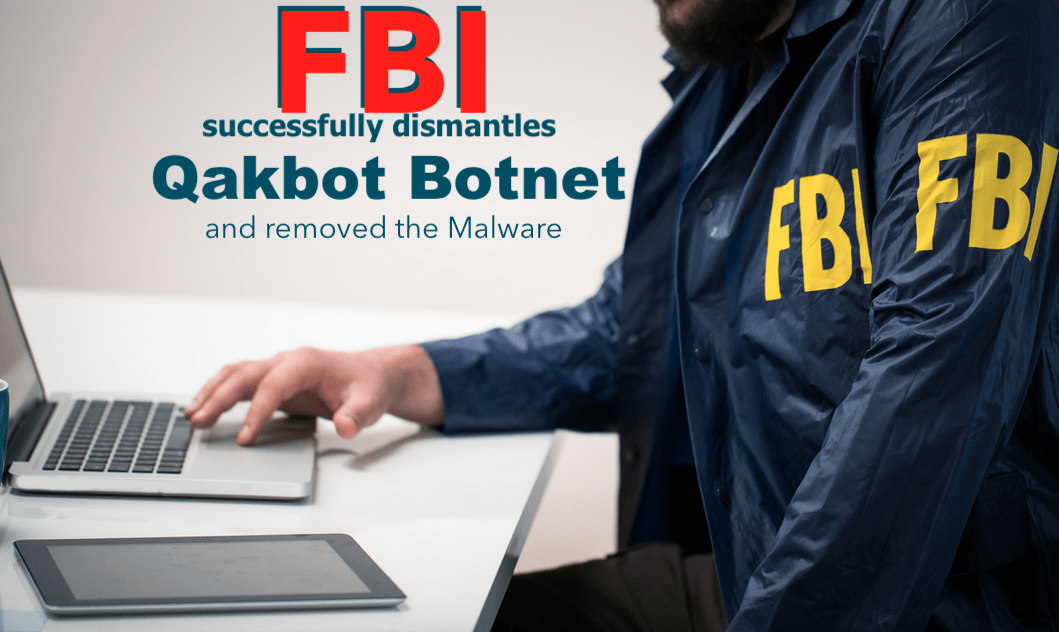In the news today, FBI’s Duck Hunt operation takes down Qakbot botnet, saving 7 lakh machines globally. The U.S. government’s domestic intelligence and security agency, the Federal Bureau of Investigation (FBI), recently reported a significant achievement. They successfully dismantled the infamous Qakbot botnet and eliminated the malware from 700,000 computers worldwide.
The FBI’s Operation Duck Hunt has successfully taken down the Qakbot malware. In a remarkable operation, the agency managed to make the massive botnet responsible for infecting over 700,000 computers uninstall itself.
Operation Duck Hunt, as it’s known, specifically targeted the Qakbot malware. This malware is known for its ability to take control of computers and then use them for various types of attacks, including launching ransomware attacks remotely. The operation aimed to disrupt and dismantle this threat.
FBI’s Operation Duck Hunt Takes Qakbot Botnet Malware Down
The U.S. government, in collaboration with international partners, has successfully dismantled a vast network of infected computers containing one of the world’s most notorious malware strains. According to the FBI, this multinational effort, led by the United States, effectively neutralized Qakbot, a malware that had infiltrated over 700,000 computers across the globe.

How Victims Were Targeted By the Qakbot Botnet Malware
The hackers behind this operation primarily targeted their victims with Qakbot by sending spam emails containing malicious attachments or links. When a victim downloaded the attachment or clicked the link, their computer would become infected with Qakbot.
Once infected, their computer would be added to a botnet, essentially a network of infected computers remotely controlled by the hackers. From this point, the bad actors could easily and effectively install other forms of malware on the victim’s devices, including ransomware.
To be sure you are safe, read this guide on How to Prevent Fraud on Credit Card with Identity Theft Detection. It will further guide you to protect your computer and mobile devices.
How did the FBI Take Down the Qakbot Botnet Malware from Computer?
In order to dismantle the network, the FBI rerouted Qakbot through servers under their control. From there, they instructed infected computers in the United States and other locations to download software designed to uninstall the Qakbot malware. This software also disconnected the infected computers from the botnet, effectively preventing further installation of malware through Qakbot.
Please note that this action by the Department of Justice (DOJ) was specific to the malware installed by Qakbot actors and did not extend to addressing any other malware that might have already been present on the victim’s computers.
Operation Duck Hunt Regions
Operation “Duck Hunt” was a collaborative effort involving not only the United States but also Europol, France, Germany, the Netherlands, the United Kingdom, Romania, and Latvia. According to U.S. authorities, the botnet was responsible for causing hundreds of millions of dollars in damages and had infected over 200,000 computers in the United States alone.
Qakbot, which has been active since 2008, has been utilized by various prolific ransomware groups over time, including Conti, REvil, MegaCortex, and others. As part of this extensive operation, the U.S. Department of Justice (DOJ) reportedly seized $8.6 million worth of extorted funds in cryptocurrency.
What the US Attorney Has to Say About the Operation and Take down of Qakbot Botnet Malware
US Attorney Martin Estrada, in a statement, highlighted the success of an international partnership led by the Justice Department and the FBI in dismantling Qakbot. He described Qakbot as one of the most notorious botnets ever, responsible for causing extensive losses to victims worldwide. Qakbot had been a preferred choice for some of the most infamous ransomware groups, but this operation has effectively eliminated it.
How you can Check if your Computer Devices Have Been Affected with Qakbot Botnet Malware?
Following the operation, the FBI has been collaborating with Have I Been Pwned, providing the compromised credentials it discovered. This partnership allows individuals to enter their email addresses on the website to check if they were among those affected. Additionally, the Dutch National Police has incorporated affected credentials into its Check Your Hack website for users to verify whether their information was compromised. There is also a Fraud Detection Algorithms done using Machine Learning and AI that you research for more updates.
Helpful Guides to Keep you Safe
- 9 Best WiFi Penetration Testing Tools Hackers Use for Wireless Security
- Safest Ways to Make Online Payment to Keep You Safe from Fraud/Theft
- How to Recover Your Money Back From a Scammer as Quick as Possible
- Account Fraud is Disrupting Online Streaming Services: See Solution here
- Prevent Yourself from Falling into Charity Scam & Fraud This Holiday Season
What is QakBot Malware?
QakBot, also known as Qbot, is a sophisticated and notorious type of botnet malware that primarily functions as a banking Trojan. It is designed to steal sensitive financial information, login credentials, and other personal data from infected computers.
What does Qbot do to your PC?
These are some key characteristics and functionalities of the QakBot botnet malware:
1. Data Theft:
QakBot primarily targets financial institutions and their customers. It is capable of stealing login credentials, banking information, credit card details, and other sensitive data. They do this by intercepting network traffic and logging keystrokes.
2. Propagation:
QakBot spreads through various means, including malicious email attachments, infected websites, and network shares. It can also propagate through removable storage devices. In addition, it can exploit vulnerabilities in the Windows operating system.
3. Persistence:
Once on a system, QakBot establishes persistence by modifying registry entries. It can then create scheduled tasks at will. Qbot malware coding makes sure that it can survive system reboots.
4. Evading Detection:
Qakbot is known for its efforts to evade detection by security software. it uses different techniques to evade detection by antivirus software and security systems. It can employ polymorphic code to change its appearance. The malware regularly updates itself to avoid signature-based detection. This makes it harder for traditional signature-based detection methods to identify it.
5. Keylogging:
The malware includes keylogging functionality, which records keystrokes made by the user. This is used to capture login credentials and other sensitive information.
6. Botnet Functionality:
Infected machines are often part of a larger botnet controlled by cybercriminals. This allows the attackers to remotely control and issue commands to the compromised machines.
7. Payload Delivery:
Qakbot can be used as a delivery mechanism for other types of malware. It can download and execute additional malicious payloads on infected machines.
8. Polymorphic Code:
It employs polymorphic code techniques to constantly change its appearance, making it more difficult for antivirus programs to detect.
9. Countermeasures:
To protect against Qakbot and similar malware, it’s essential to keep your operating system and software up to date, use reliable antivirus and anti-malware software, exercise caution when opening email attachments or clicking on links, and regularly back up your data.
This report is about the FBI’s Duck Hunt operation that took down Qakbot, saving 7 lakh machines around the world.
Related Posts
- How Apple Pay Visa Contactless Hack Happen? Researchers find Answers
- Simple Ways Cyber Criminals Hack Facebook Account – Don’t Fall a Victim
- 16 Best Ethical Hacking Courses on Udemy Website to Register and Learn
- Best Windows PenTesting Ethical Hacking Tools & Techniques for DevOps
- Fedex Fraudulent Email Alert – Unauthorized use of FedEx® Business Delivery







